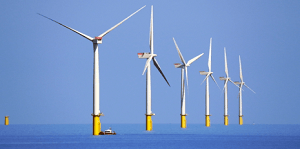Sep 7 2016
 Offshore wind farms - the wind farm Walney in northwest England is shown - will produce significantly more wind power in the future. (Image: David Dixon / Wikipedia / CC 2.0)
Offshore wind farms - the wind farm Walney in northwest England is shown - will produce significantly more wind power in the future. (Image: David Dixon / Wikipedia / CC 2.0)
Stefan Pfenninger, ETH researcher, together with his colleague Iain Staffell, from Imperial College London, have created new multi-decade simulations of wind power production in Europe. This new invention has helped them to discover vital distortions in the previously used data, and they also developed new simulations of wind power output with country-specific modifications.
There has been a huge surge in wind power capacity both in Europe and the rest of the world. In 2015, the global installed capacity reached almost 350 GW, with 135 GW installed in Europe, distributed through some 87,000 wind turbines.
Wind power currently provides a bigger share (13%) of electricity than nuclear power stations. In Germany, Denmark, and Spain, the quantity of wind power already installed is in theory enough to meet the nationwide demand for electricity under suitable conditions (maximum wind power output and low consumer demand).
Inconsistent Output
The quantity of installed capacity reveals very little about the amount of electricity that is fed into the national grid by the wind fleet of a particular country. Compared to nuclear power, wind is difficult to predict by nature. This complicates the task of connecting wind farms to existing power grids.
Energy providers and energy researchers require electricity production to be simulated across a limited time period in order to accurately determine how high the load could be at any point in time.
Researchers have already started to carry out such simulations using “reanalysis” models: global meteorological models fed with measured data generated from satellites and weather stations, which process these measurements into a consistent world-wide simulation of atmospheric conditions.
Critical Review of Weather Models
One significant drawback of data from reanalysis is that meteorological models, which simplify the actual world, do not offer detailed simulation of factors that are vital for wind power, such as the topology surrounding a wind farm.
If data obtained from reanalysis models is utilized to simulate wind power production without any modification, then the models are capable of developing a systematically distorted picture. However, several studies on wind power generation based on uncorrected data have still been published.
This motivated both Pfenninger and Staffell to develop a huge database of recorded electricity output from wind farms spread across Europe, and also country-wide production data based on reports presented by transmission network operators.
The researchers were also inspired to use this database to obtain correction factors for every single European country. The Virtual Wind Farm Model (VWF) was then used by the researchers to simulate wind power production in Europe over a period of 20 years.
Fresh Simulation of Output
The two researchers used a rigorous approach to develop a realistic picture of wind energy output in Europe. Their modified simulations highlighted that the uncorrected simulations used in several other studies have overestimated the output of wind power in north-western Europe by up to 50%, while underestimating it by almost 30% in southern Europe.
The capacity factors for Europe were also recalculated: the existing European average is 24.2%, in comparison to 32.4% in the UK and 19.5% in Germany. The European average varies by just a few percent from one year to the next.
This fluctuation is much less than the deviation observed in individual countries. The bigger the wind fleet and the wider the geographical footprint, the smaller the fluctuations on the supply side.
Stefan Pfenninger, Researcher, ETH
It is vital for national grids to be interconnected in an efficient manner that will allow power outages in one country to be offset with excess output in another country.
The simulation also highlights improvement in the capacity factors, thanks to the technological enhancements and improved offshore locations. Britain’s wind parks are currently 25% more productive than they were 10 years ago.
North Sea Countries in Expansion Mode
With the existing state of planning, Pfenninger and Staffell predict that Europe’s average capacity factor could increase by a third, to more than 31%.
Countries adjoining the North Sea should experience particularly strong growth in the near future.
Stefan Pfenninger, Researcher, ETH
The UK will be able to attain a capacity factor of almost 40%, and Germany will be close to 30%.
Pfenninger and Staffell have developed an interactive web application to help utility companies, network operators, planners and other scientists to continue using the simulations produced by the energy researchers. The European data sets can also be downloaded.
This new web application provides access to data from a study published at the same time, which produces simulation of Europe’s photovoltaic power output. For six months, both Pfenninger and Staffell have been beta testing Renewables.ninja and currently have users from 54 institutions spread across 22 countries, also including IRENA and the International Energy Agency.